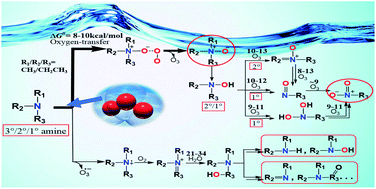Degradation mechanisms of simple aliphatic amines under ozonation: a DFT study†
Abstract
Aliphatic amines as common constituents of dissolved organic nitrogen (DON) exhibit high reactivity during ozonation; however, our understanding of their degradation mechanisms is very limited. In this study, methylamine (MA) and ethylamine (EA), as well as their secondary and tertiary amines (DMA, DEA, TMA and TEA) were chosen as aliphatic amine models and their degradation mechanisms during ozonation were investigated by using the DFT method. The oxygen-transfer reaction occurs initially and rapidly in the ozonation of all the above amines with a ΔG≠ value of 8–10 kcal mol−1 in great agreement with the experimental rate constant of 104 to 107 M−1 s−1. Moreover, N-oxide as the main degradation product for tertiary amines directly forms after oxygen-transfer, while nitroalkanes as main products for secondary and primary amines are yielded after a series of reactions mediated by hydroxylamine and nitrosoalkane with a ΔG≠ value of 10–13 kcal mol−1. Regarding the minor N-dealkylated products for all amines, alkylamino alcohol is an important intermediate possibly generated via a radical reaction pathway with a ΔG≠ value of 21–34 kcal mol−1. Additionally, comparison of the reactivity of aliphatic amines, hydroxylamines and alkylamino alcohols with ozone was made and elucidated in this study. The results are expected to expand our understanding of the degradation mechanisms for nitrogenous compounds during ozonation.

- This article is part of the themed collection: SDG13: Climate Action- chemistry of greenhouse gases, 2022


 Please wait while we load your content...
Please wait while we load your content...